QRadar Release Notes - Juniper Networks
QRadar Release Notes - Juniper Networks
QRadar Release Notes - Juniper Networks
You also want an ePaper? Increase the reach of your titles
YUMPU automatically turns print PDFs into web optimized ePapers that Google loves.
STRM RELEASE NOTES<br />
RELEASE 2008.3 - REVISION 2<br />
FEBRUARY 2009<br />
<strong>Juniper</strong> <strong>Networks</strong> is pleased to introduce STRM 2008.3. This release provides you<br />
with several resolved issues and enhanced functionality.<br />
This document includes:<br />
• New and Updated Functionality<br />
• Technical Documentation<br />
• Contacting Customer Support<br />
• Resolved Issues<br />
• Known Issues and Limitations<br />
• Upgrade Considerations<br />
• Documentation Addendum<br />
New and Updated<br />
Functionality<br />
STRM 2008.3 provides you with the following new and updated functionality:<br />
• Event Viewer and Flow Viewer Enhancements - The Event Viewer and Flow<br />
Viewer provides the following enhancements:<br />
- New Right Click Filtering Options - You can now use the right mouse<br />
button (right-click) to access additional event filter information.<br />
- Resizable columns - You can now resize any column by pointing your<br />
mouse over the column divider and dragging the column to the desired size.<br />
You can also double-click the column divider to automatically resize the<br />
column to the width of the largest field.<br />
- Improved Flow and Event Viewer Charts - The Event Viewer and Flow<br />
Viewer details window now displays a pie chart in addition to the bar chart.<br />
Also, chart colors are enhanced to make the charts more meaningful.<br />
- Default Searches - You can now choose any saved event or flow search to<br />
run and display search results in the default view when you launch the Event<br />
Viewer or Flow Viewer.<br />
- Custom Columns and Groupings - You can now choose which columns<br />
you want to display in saved search results. You can also choose how you<br />
want to group the columns.<br />
530-028582-01
2 STRM RELEASE NOTES<br />
- Custom Event Properties - You can now create Custom Event Properties,<br />
which you can use to extract unnormalized data from event payloads.<br />
Custom Event Properties allow you to search, view, and report on<br />
information within logs that STRM does not typically normalize and display.<br />
• Reports Enhancements - The Reports interface provides the following<br />
enhancements:<br />
- Default report templates - Provides new default report templates that you<br />
can use to create high-level and device-specific reports.<br />
- Reports Leverage Event and Flow Searches - Due to enhancements to<br />
the event and flow search functionality, you can now choose which columns<br />
you want to display in your reports and define how the column are grouped<br />
with the reports.<br />
- Time Series Chart Enhancements - The time series reports provide the<br />
following enhancements:<br />
Event and Flow Search Data - Time series charts can derive data from<br />
saved event and flow searches.<br />
Configurable Axis - You can now configure the X and Y axis for Event/Logs<br />
and Flow report charts.<br />
Graph Total - You can now display the graph value of an object plotted in a<br />
chart.<br />
New Graphing Options - Two new graphing options are introduced for time<br />
series charts: Line and Stacked Line.<br />
- Report Template Generation Status - When you manually generate a<br />
report, you can now view the generation status in the Next Run Time<br />
column. The status specifies when the report is generating and, if queued,<br />
the position in the queue. The status also specifies the estimated time to<br />
generate the report.<br />
• Dashboard Enhancements - The Dashboard interface provides the following<br />
enhancements:<br />
- Search-Based Dashboard Items - You can now add Dashboard items that<br />
are based on saved event and flow searches. After you add an<br />
search-based Dashboard item, you can further customize the item by<br />
choosing whether the data will be displayed in a bar, table, or pie chart.<br />
- Default Dashboard for New Users - When a new user accesses STRM<br />
2008.3, a default Dashboard is displayed. In earlier versions of STRM, a<br />
new user had to built their own Dashboard.<br />
• User Role Permissions - The user role functionality provides the following<br />
enhancements:<br />
- Device Permissions - If a user role has Event Viewer permissions,<br />
Administrators can now specify which devices the user role has access to.<br />
- Event Permissions Precedence - Administrators can now specify which<br />
permissions take precedence for all users.<br />
530-028582-01
New and Updated Functionality 3<br />
• Offense Manager Enhancements - The Offense Manager interface provides<br />
the following enhancements:<br />
- Rules Contributing to Offenses - The Offense Summary now displays a<br />
list of rules contributing to the offense. From the list, you can access the<br />
Rules Wizard to edit a selected rule.<br />
- New Offense Property Tests for Custom Rules - You can configure<br />
notifications by creating custom rules that include new offense property<br />
tests: when a new offense has been created and when the offense<br />
property has increased by at least this percent. These rule tests can be<br />
combined with other tests.<br />
- More Information Included in Alerts or Response Notifications -<br />
Additional fields are now included in alerts or response notifications. To<br />
support this enhancement, a new SNMP trap ensures that parameters are<br />
separate fields within the trap.<br />
- On Demand Offense Alert or Response Notification - In previous<br />
releases, the Email option allowed you to configure notification settings. This<br />
functionality has been migrated to the custom rule engine. Now, the Email<br />
option allows you to immediately send an e-mail containing all displayed<br />
information about the offense in text format.<br />
• Device Parsing Order - You can now configure the order that you want each<br />
Event Collector in your deployment to parse events from external devices,<br />
called Device Support Modules (DSMs). Defining the parsing order for DSMs<br />
ensures that the required DSMs are parsed in a specific order, regardless of<br />
changes to the DSM configuration. This ensures system performance is not<br />
affected by changes to DSM configuration by preventing unnecessary parsing.<br />
• Authorized Services - You can now configure authorized services in the<br />
Administration Console to pre-authenticate a customer support service for your<br />
STRM deployment. By authenticating a customer support service, you allow the<br />
service to connect to your STRM interface to dismiss or close offenses, and<br />
update offense notes. You can add or revoke an authorized service at any time.<br />
• QID Map Utility - STRM 2008.3 introduces a new utility to manage the STRM<br />
Identifier (QID) map. The QID map provides the association or mapping of an<br />
event of an external device to a QID. You can use the QID map utility to create,<br />
export, import, or modify user-defined QID map entries.<br />
• ISP Template - The ISP template has been removed.<br />
• IPv6 Management and Monitoring Support - STRM 2008.3 now supports<br />
deployment in both IPv4, IPv6, or mixed environments. IPv4 and IPv6<br />
addressing is supported for network connectivity and management of STRM<br />
software and appliances.<br />
530-028582-01
4 STRM RELEASE NOTES<br />
Technical<br />
Documentation<br />
You can access technical documentation, technical notes, and release notes<br />
directly from the <strong>Juniper</strong> Customer Support web site at<br />
https://www.juniper.net/support/. Once you access the <strong>Juniper</strong> Customer Support<br />
web site, locate the product and software release for which you require<br />
documentation.<br />
Your comments are important to us. Please send your e-mail comments about this<br />
guide or any of the <strong>Juniper</strong> <strong>Networks</strong> documentation to:<br />
techpubs-comments@juniper.net.<br />
Include the following information with your comments:<br />
• Document title<br />
• Page number<br />
Contacting<br />
Customer Support<br />
To help you resolve any issues that you may encounter when installing or<br />
maintaining STRM, you can contact Customer Support as follows:<br />
• Open a support case using the Case Management link at<br />
http://www.juniper.net/support/<br />
• Call 1-888-314-JTAC (from the United States,Canada, or Mexico) or<br />
1-408-745-9500 (from elsewhere).<br />
Supported Devices<br />
and OS Versions<br />
STRM 2008.3 supports platforms from multiple vendors. Table 1 lists <strong>Juniper</strong><br />
<strong>Networks</strong> device families and operating systems that support NSM. The table<br />
shows whether a device requires STRM to forward logs through NSM.<br />
Table 1 Supported <strong>Juniper</strong> <strong>Networks</strong> Devices and OS Versions<br />
Device Family OS<br />
Logs Sent Directly to<br />
STRM from Device<br />
ISG-IDP 6.0, 6.1.0r4 No Yes<br />
FW/VPN 6.0, 6.1.0r4 Yes Yes<br />
Standalone IDP 4.1R3 Yes Yes<br />
J-series 8.5, 9.0, Yes<br />
No<br />
9.1,9.2r1.10<br />
Secure Access (SA) 6.3R1 Yes No<br />
2.2R3 Yes No<br />
Infranet Controller<br />
(IC)<br />
EX-series 9.1R2.10,9.2 Yes No<br />
M-Series 9.2 Yes No<br />
Logs Sent<br />
Through NSM to<br />
STRM<br />
530-028582-01
Resolved Issues 5<br />
Table 1 Supported <strong>Juniper</strong> <strong>Networks</strong> Devices and OS Versions<br />
Logs Sent<br />
Logs Sent Directly to Through NSM to<br />
Device Family OS<br />
STRM from Device STRM<br />
MX-Series 9.2 Yes No<br />
T-Series 9.2 Yes No<br />
Note: For STRM to correctly process logs from SA and IC, the logs should be sent<br />
from the devices in WELF format. To enable WELF format on the device: Under<br />
System > Logs > Events > Settings, select the WELF filter for the syslog (STRM)<br />
server entry in this table. To parse logs from IC devices, the IC device needs to be<br />
manually added under Sensor Devices.<br />
Supported Java and Browser Software<br />
STRM supports the following versions of Java and browsers:<br />
• Java version 1.5 and later<br />
• Internet Explorer version 7<br />
• Firefox version 2.0 and above.<br />
Resolved Issues This section describes the resolved issues in STRM 2008.3:<br />
Configuring an Asset Profile View of 0 No Longer Causes Errors<br />
In the STRM System Settings, you can configure the Asset Profile View parameter<br />
to specify the views you wish the system to use when accumulating asset profile<br />
data. By default, the list includes the following views: 1, 2, 15, and 16. Previously, if<br />
you set a view to 0, an error would appear in the log files. Also, if you upgraded to<br />
STRM 2008.2R1, any Asset Profile View set to 0 was automatically changed to a<br />
value of 16.<br />
This no longer occurs. If you set a view to 0 in STRM 2008.3, a message appears<br />
to advise you that the asset profile views list contains an invalid view ID.<br />
Offense Manager Now Displays Associated Events<br />
Previously, if an event associated with an offense included a destination IP<br />
address of 0.0.0.0, the event did not appear in the Offense interface summary or<br />
Events list. This no longer occurs.<br />
Exported Flow Data Now Contains Payload<br />
Using the Flow Viewer, you can export flow data in CSV or XML format. if you<br />
exported flow data that includes payload information, the exported file did not<br />
include the payload information. This no longer occurs.<br />
DoS Rules No Longer Detecting Attacks Without Contributing to the Offense<br />
Previously, DoS rules were generating offenses, but it was not easy to identify<br />
which rules were generating the offenses. This no longer occurs. In all templates,<br />
530-028582-01
6 STRM RELEASE NOTES<br />
the rules have been modified to create event names that are easier to correlate to<br />
the rules that generated them.<br />
Sorting Columns in Offense Search Results No Longer Causes Interface to<br />
Display Inaccurate Search Results<br />
Previously, if you searched for an offense and then sorted a column in the search<br />
results, the display reverted to a list of offenses that is not valid for the defined<br />
search. This no longer occurs.<br />
Tomcat No Longer Requires an Extended Time to Restart When Parsing<br />
Report Templates<br />
Previously, a report template parsing problem may have caused the Tomcat server<br />
to take an extended period of time to restart.<br />
Network Hierarchy Now Saves Properly<br />
When defining your network hierarchy, you can use the Re-Order button to arrange<br />
your network objects. Previously, once saved, the new order reverted to the<br />
previous order. This no longer occurs.<br />
Port 0 Now Valid in a Rule or Building Block<br />
Previously, the valid range for port values in rules or building blocks was 1 to<br />
65535. Therefore, port 0 was an invalid port. The valid range for source,<br />
destination, local, and report ports in rules or building blocks is now 0 to 65535.<br />
Large Data Backups No Longer Fail<br />
Previously, when a large number of files were included in the data backup process,<br />
the backup may have failed. This no longer occurs.<br />
Unknown Traffic Now Mapping Between Network Surveillance and Flow<br />
Viewer Interfaces<br />
Previously, when you clicked the View Flows button for unknown traffic displayed<br />
in the Network Surveillance interface, no flows were displayed. This was because<br />
the corresponding data in the Flow Viewer was marked as other, while the Network<br />
Surveillance interface was looking for unknown. This no longer occurs. Now,<br />
unknown items are marked at other in the Network Surveillance interface.<br />
Backup Archive Now Only Includes Necessary Files<br />
Previously, the backup process included files that did not need to be included in<br />
the backup. This resulted in backup archive files that were larger than necessary.<br />
This no longer occurs.<br />
STRM User Interface Ceases to Function When Locks Occur in Postgres<br />
Database<br />
Previously, if Postgres database locked up, the STRM user interface would cease<br />
functioning in a tunneled deployment. This problem no longer occurs, due to the<br />
Transaction Sentry. The Transaction Sentry functions by detecting stalled or<br />
locked applications. If erroneous processes are found, the Transaction Sentry<br />
530-028582-01
Resolved Issues 7<br />
returns the process to a usable state. Now, you can configure the Transaction<br />
Sentry to resolve erroneous or locked transactions on a tunneled deployment<br />
(encrypted host). For more information, see STRM Administration Guide,<br />
Configuring System Settings.<br />
AQL Now Respecting Search Time Limit<br />
Previously, AQL searches extended for a longer period than configured in the<br />
exectime parameter. This parameter specifies the maximum<br />
period of time, in seconds, a single query may continue processing; however,<br />
Asset Profile History No Longer Searches Over 2000 Results Causing<br />
Tomcat Failure<br />
Previously, when you performed an Asset Profile search using the History option,<br />
the search would try to return all results in history causing the tomcat server to fail.<br />
This no longer occurs. The search will now return only the last 2000 records.<br />
AQL No Longer Requires Root User Login<br />
Previously, you had to log into AQL as root. This no longer applies. You can log<br />
into AQL as any user that has access privileges.<br />
DiskMaintd No Longer Generating Unnecessary E-mails<br />
Previously, the nightly cron job (diskmaintd) was generating unnecessary e-mails,<br />
based on directory errors. This no longer occurs.<br />
Device Extensions Enhancement Now Displays Proper Time<br />
Previously, enhancement-based extensions (extensions that parse null events<br />
from scratch) did not display the correct time in the corresponding event records.<br />
This no longer occurs.<br />
Users Can Now Include Shared Searches in Their Quick Search List<br />
Previously, the Include in my Quick Searches feature was not working properly. If<br />
the owner of a search selected to share the search with everyone, other users<br />
could access and use the search, but could not Include the search in their quick<br />
search list. This no longer occurs.<br />
Truncated sFlow Packets Now Generating IP Addresses in the Flow Viewer<br />
Previously, sFlow data appears in the Flow Viewer with a source and destination IP<br />
address of 0.0.0.0. The problem occurred with sFlow records with packet headers<br />
that are truncated at layer 4. The truncated packet headers result in flows with IP<br />
addresses, but no port information. This no longer occurs. The Flow Collector has<br />
been modified to capture the IP address, even if the packet is truncated.<br />
NSF Backups No Longer Generating Extra Flow Traffic<br />
Previously, Network File System (NFS) traffic was increasing flow rates on the<br />
Flow Collector during the NFS backup. This no longer occurs.<br />
530-028582-01
8 STRM RELEASE NOTES<br />
Restore Process Not Checking Version/Patch Level of Backup Files<br />
Previously, restoring a backup to a newer version of STRM was unsuccessful, but<br />
no error message appeared. Now when you restore a backup to a newer version<br />
of STRM, the version and patch level of the backup files are checked. If the<br />
version/patch level is older than the version you are restoring to, a message will<br />
appear to indicate that the backup cannot be restored. We recommend that<br />
upgrade to latest build indicated in the message.<br />
Hostcontext No Longer Fails on Monitored STRM Processes<br />
Previously, hostcontext would suspend monitoring on core component processes<br />
that were required to run STRM, such as encrypted connections back to the<br />
Console when the Console was unavailable for extended periods of time, or<br />
startup errors on processes, such as flow classification. This no longer the case.<br />
Hostcontext no longer stops attempting to restart required processes.<br />
Period character “.” in Network Hierarchy Group Names Now Supported<br />
Previously, problems were encountered when adding a group that contained the<br />
period character “.” in the Network Hierarchy. This no longer occurs and periods<br />
are supported.<br />
Special Characters Now Permitted in Passwords For Checkpoint Firewall<br />
Previously, if an operation security (OPSEC) password for a CheckPoint Firewall<br />
certificate had a special character, such as "|", the characters after the special<br />
character were interpreted as a command, which caused the certificate to fail. This<br />
no longer occurs.<br />
JDBC Siteprotector Drop Down List Box Option No Longer Causes an Error<br />
Previously, an error occurred when selecting the JDBC:SiteProtector option from<br />
the Protocol drop down-list box when configuring protocols. This no longer occurs.<br />
Offense rules Now Sending E-mail and Syslog Notifications Correctly<br />
Previously, offense rules with notification set to email or syslog did not work<br />
properly. The offense rule did not generate e-mails or syslog entries.This no longer<br />
occurs.<br />
Known Issues and<br />
Limitations<br />
This section describes the known issues and limitations for the following areas:<br />
• General<br />
• System Configuration<br />
• Deployment Editor<br />
• Network Surveillance<br />
• Offense Manager<br />
• Event Viewer<br />
• Flow Viewer<br />
530-028582-01
Known Issues and Limitations 9<br />
• Reports<br />
• Asset Manager<br />
General<br />
Objects Menu Tree May Not Appear in Equation Editor After Adding a New<br />
Custom View<br />
If you create a new Custom View and then open the Equation Editor, the menu tree<br />
displaying network objects may not appear the first time you attempt to access the<br />
menu tree. However, if you choose a new object using the drop-down list box, the<br />
menu tree appears.<br />
Workaround: Close the Equation Editor window and then re-open it.<br />
Exporting Information Using CSV/XML Export may be Blocked Using Internet<br />
Explorer 7<br />
If you wish to download information (such as events, assets, or flows), using the<br />
STRM Export function, you can select the Notify When Done option that enables<br />
the browser to notify you when the download is complete. However, if you are<br />
using Internet Explorer 7, a warning appears requiring you to select an option<br />
menu to download the file. When you select the option menu, the browser<br />
refreshes to the STRM Dashboard and the exported file is not downloaded.<br />
Workaround: In Internet Explorer 7, change the Security Settings > Downloads ><br />
Automatic Prompting for file downloads option to Enable.<br />
Items Assigned to a User May Not Be Removed After Deleting the User<br />
After you delete a user, items such as saved searches, reports, sentries, and<br />
assigned offenses, will remain associated with the deleted user. There are no<br />
warnings or errors resulting from this issue.<br />
Workaround: None<br />
Restored System That Includes Scanner May Cause Tomcat Server Failure<br />
If you restore a system that includes scanners or DSMs installed as plug-ins, the<br />
Tomcat server may fail to restart.<br />
Workaround: Before restoring STRM, re-install any DSM or scanner plug-ins. For<br />
more information on scanners and DSMs, see the <strong>Juniper</strong> Customer Support web<br />
site.<br />
Potential File System Corruption After a Power Outage or Hard Reboot<br />
After a power outage or hard reboot of a STRM appliance, the file system could<br />
potentially be corrupted.<br />
Workaround: Use Uninterrupted Power Supply (UPS) on all STRM appliances and<br />
avoid hard reboots.<br />
Time Setting on Quick Searches Incorrect<br />
The incorrect time shows on a quick search if you saved the search with the<br />
Include with time and Include in quick searches options selected. This only<br />
530-028582-01
10 STRM RELEASE NOTES<br />
occurs when you save the search directly from the results screen, and not from<br />
Saved Searches screen.<br />
Workaround: If you want to configure a search as a quick search and include with<br />
time, click Saved Searches and configure the necessary parameters.<br />
Devices sending logs through NSM will get AutoDeteceted as<br />
“NetscreenNSM”.<br />
Workaround: NSM can still be used as a central management tool however<br />
have all devices send their Syslog to STRM directly.<br />
STRM does not support Structured Syslog sent by IDP.<br />
Workaround: None. Need to be fixed in future release.<br />
JunOS devices gets autodetected as “<strong>Juniper</strong> Router”.<br />
Workaround: Add the M, MX, T-Series routers manually.<br />
StandaloneIDP gets autodeteceted as “NetscreenFirewall”.<br />
Workaround: Manually Add Device as “<strong>Juniper</strong>IDP”.<br />
An auto-discovered Infranet Contoller may appear incorrectly as a<br />
“<strong>Juniper</strong>SA”, “<strong>Juniper</strong> <strong>Networks</strong> Secure Access (SA) SSL VPN” device.<br />
Workaround: Add this device manually in Sensor Devices.<br />
An auto-discovered EX-Series Ethernet Switch may appear incorrectly as a<br />
“<strong>Juniper</strong>Router”, “<strong>Juniper</strong> <strong>Networks</strong> Routing Platform” device.<br />
Workaround: Add the EX-Series Ethernet Switch manually.<br />
New Reporting structure<br />
This is only available on Fresh install of 2008.3.<br />
Recovery partition<br />
This is only available on Fresh Install of 2008.3. Refer to<br />
"Add-Recovery-ReinstallingSTRM" for recovery partition on devices upgraded<br />
from 2008.2r2 to 2008.3.<br />
<strong>Juniper</strong> <strong>Networks</strong> Net-Screen Security Manager(NSM) is renamed as<br />
<strong>Juniper</strong><strong>Networks</strong> Network & Security Manager(NSM). STRM still uses the old<br />
naming convention for NSM.<br />
Workaround: None.<br />
Often, the event viewer gives an error message as “There is a problem<br />
connecting to the query server, please try again later”.<br />
Workaround: Multiple refreshes or select another search pattern for the Events.<br />
Custom Event properties<br />
530-028582-01
Known Issues and Limitations 11<br />
This is only available on Fresh Install of 2008.3.<br />
System<br />
Configuration<br />
Installation With a Potentially Corrupt Zip File<br />
When you deploy configuration changes in STRM, the following error may appear<br />
in the log file: Failed to unpack new configuration files. This error<br />
condition may the result of a corrupted zip file.<br />
Workaround: In the STRM Administration Console, select Configurations ><br />
Deploy All.<br />
Error Appears in Log File If Deployments Includes RPM Installed Scanners<br />
and DSMs Prior to Upgrade<br />
If your deployment includes DSMs or scanners installed using an .rpm file, the<br />
following error appears in the log files after you upgrade your system to STRM<br />
2008.3:<br />
ErrorStream ExecuteAutoUpdate-Deploy: Can't load '/opt/strm/<br />
perl5libs/lib/site_perl/5.6.1/i686-linux-thread-multi/auto/XML/<br />
Parser/Expat/Expat.so' for module XML::Parser::Expat: /opt/<br />
strm/perl5libs/lib/site_perl/5.6.1/i686-linux-thread-multi/auto<br />
/XML/Parser/Expat/Expat.so: wrong ELF class: ELFCLASS32 at<br />
/usr/lib64/perl5/5.8.8/x86_64-linux-thread-multi/DynaLoader.pm<br />
line 230<br />
This error does not affect the upgrade process or system functionality and can be<br />
ignored.<br />
Workaround: None<br />
Deployment Editor<br />
Network Surveillance<br />
Able to Configure Scanner Assignments for Last Entered IP Address<br />
When configuring scanner assignments, you are able to enter multiple IP<br />
addresses; however, scanner assignment configurations are applied only to the IP<br />
address that was entered last.<br />
Workaround: Create scanner assignments for one CIDR address at a time.<br />
Graph By Lines Option May Display Multiple Lines with Same Color<br />
When you are viewing a graph that includes multiple network view objects, the<br />
graph may display multiple view objects using the same color since the colors are<br />
based on the network. For example, if you are viewing the Chat, Mail, and web<br />
components in an Application View, each data set is different, however, since they<br />
are based on the same network, STRM interprets the data as one, displaying each<br />
component with the same color.<br />
Workaround: None<br />
530-028582-01
12 STRM RELEASE NOTES<br />
Sentry Wizard Sensitivity Slider Is Reading From Lowest To Highest<br />
When setting the alert sensitivity in the Sentry Wizard, the slider has a reading of 0<br />
to 100. Increasing the slider to a higher number results in a lower sensitivity<br />
reading.<br />
Workaround: Position the slider to zero to increase the sensitivity rating.<br />
Offense Manager<br />
An IP Address Previously Identified as a Remote Attacker Can Not Be<br />
Created as an Offense When Creating a New Network<br />
Even if your network hierarchy is not defined, STRM can start generating offenses.<br />
However, STRM records all generated offenses as remote offenses since no local<br />
systems are defined in your network hierarchy. If this occurs, any IP address that<br />
has been previously defined as a remote attacker can not be created as an offense<br />
when defining your network.<br />
Workaround: You must restart the Event Correlation System (ECS). From the<br />
command prompt, type service ecs restart. Also, make sure your network<br />
hierarchy is defined.<br />
Overlapping CIDR(s) in Network Hierarchy Configuration Allows Users to<br />
View Assets to Which They Have No Access<br />
If your network hierarchy configuration includes overlapping CIDR ranges, a STRM<br />
non-administrative user is able to view assets for which they have no access. They<br />
can view a list of the restricted assets by clicking Search or Show All in the Asset<br />
Profile window of the Offense Manager. However, an error appears if the user<br />
attempts the edit the asset or view detailed information.<br />
Workaround: None.<br />
Viewing a List of Attackers May Display Blank Pages<br />
The Offense Manager allows you to view a list of attackers for a network. If your<br />
system includes closed offenses that have been removed from the database, the<br />
list of attackers may not return the same number of results as the attacker count. If<br />
the list of attacker results are returned over multiple pages, there may be several<br />
blank pages at the end of the results. All results are included in the output.<br />
Workaround: Click on the previous page to view information.<br />
Event Viewer<br />
Unable to Remove Custom Event Mapping<br />
Once you create a custom event mapping using the event mapping tool in the<br />
Event Viewer, you are able to edit the mapping, however, you are unable to<br />
remove the event mapping or restore default settings.<br />
Workaround: None.<br />
Mapping Events to the Unknown/Stored Events Category<br />
Using the Map Event button available in the Event Details window, you can map<br />
events to the Unknown/Stored category. Please note that after you map an event<br />
530-028582-01
Known Issues and Limitations 13<br />
to the Unknown/Stored category, you cannot change the mapping. STRM does not<br />
allow events in the Unknown / Stored category to be remapped to a new category.<br />
Workaround: Avoid mapping events to the unknown/stored category.<br />
Using Certain Offense Property Tests and Device Tests in Same Rule May<br />
Cause the Rule to Not Function<br />
Using Certain Offense Property Tests and Device Tests in Same Rule May Cause<br />
the Rule to Not Function. If you use the following tests in the same rule, the rule<br />
may not generate offenses, as expected:<br />
• Offense Property Tests: when a new offense is created<br />
• Device Tests: when the device type(s) that detected the offense is one of the<br />
following types<br />
An error may appear and the rule does not generate offenses.<br />
Workaround: None.<br />
Flow Viewer<br />
Unable to Double-Click on Unioned Flow to Access Additional Information<br />
If you wish to access additional information on a unioned flow in the Flow Viewer,<br />
the option to double-click on a flow is disabled.<br />
Workaround: Using the search function in the Flow Viewer, search flows based on<br />
the union flows that you wish to isolate by using the right-mouse button (right-click)<br />
on the source/ destination IP address, ports, and protocols. Once the details of the<br />
flows appears, select the None option from the Display drop-down list box.<br />
Search for (SrcIP = x or SrcIP = Y) and (DstIP = x or DstIP = y) Returns Too<br />
Many Results<br />
If you perform a search with the parameters (SrcIP = x or SrcIP = Y) and (DstIP = x<br />
or DstIP = y), invalid results are returned. This search should look for all traffic<br />
between the specified source IP address and destination IP address, but it returns<br />
results for all traffic for either IP address.<br />
Workaround: None<br />
Reports<br />
Reports Based on Specific Flow Columns and Groupings Stops Collecting<br />
Data After Upgrade<br />
Due to improvements made in STRM 2008.3 to support customizable column<br />
definitions, reports collecting data based on flow-based searches involving the<br />
following flow columns and groupings, will stop collecting data:<br />
• ICMP Type<br />
• Flow Source<br />
• Flow Source/Interface<br />
• Source QoS<br />
• Destination QoS<br />
• Application/Source QoS/Destination QoS<br />
530-028582-01
14 STRM RELEASE NOTES<br />
To begin collecting data for these reports again, you will need to create a new<br />
report using the previously saved flow search.<br />
Workaround: None<br />
Asset Manager<br />
Unable to Save Approved Servers When More Than 1000 Results are<br />
Returned<br />
The Server Discovery function does not save approvals when the more than 1000<br />
results are returned for Windows Server and Web Server. This may also occur<br />
when selecting a sub-network group that shows less than 1000 results.<br />
Workaround: None.<br />
Upgrade<br />
Considerations<br />
Before you upgrade to 2008.3 version of STRM, make sure you are running<br />
2008.2r2 version. If you are running versions earlier than 2008.2r2, first upgrade to<br />
2008.2r2 before upgrading to 2008.3 version. STRM can be upgraded to 2008.3<br />
version only from 2008.2r2 version.<br />
Documentation<br />
Addendum<br />
Free Space<br />
Requirement for<br />
Upgrades<br />
Flow Viewer<br />
Parameters<br />
This section includes documentation updates including:<br />
• Free Space Requirement for Upgrades<br />
• Flow Viewer Parameters<br />
• Resizing Columns<br />
• System Summary Permissions<br />
• Default Building Blocks<br />
• Updating Your Host Set-up<br />
• Integration of New QIDs into QID Map<br />
• Accessing STRM Using Mozilla Firefox 3.0<br />
The STRM 2008.3 upgrade requires a minimum of 2 GB of free disk space. The<br />
upgrade process validates actual disk space required for your STRM configuration<br />
and determines if enough disk space is available. If your system does not have<br />
enough free disk space, the upgrade process stops and a message appears<br />
warning you that additional disk space is required to perform the upgrade.<br />
The following parameters have been added to the Flow Viewer Parameters table in<br />
the STRM Users Guide - Using the Flow Viewer chapter:<br />
Table 2 Flow Viewer Parameters<br />
Parameter<br />
Bytes In<br />
Bytes Out<br />
Description<br />
Specifies the number of bytes sent to the local network.<br />
Specifies the number of bytes sent from the local network.<br />
530-028582-01
Documentation Addendum 15<br />
Table 2 Flow Viewer Parameters (continued)<br />
Packets In Specifies the number of packets sent to the local network.<br />
Packets Out Specifies the number of packets sent from the local network.<br />
530-028582-01
16 STRM RELEASE NOTES<br />
The following parameter has been modified in the Flow Viewer Parameters table in<br />
the STRM Users Guide - Using the Flow Viewer chapter:<br />
Table 3 Flow Viewer Parameters<br />
Parameter<br />
ICMP Type<br />
Description<br />
Specifies the ICMP type and code, if applicable.<br />
If the flow has ICMP type and code information that is not in a<br />
known format, the field displays as Type , Code , where<br />
A and B are the numeric values of the type and code.<br />
The ICMP Code column has been removed from the Flow Viewer Parameters<br />
table.<br />
Resizing Columns<br />
System Summary<br />
Permissions<br />
The STRM Users Guide details how to resize the columns of the Flow Viewer and<br />
Event Viewer display. You can also resize columns by double-clicking the line that<br />
separates the columns to automatically resize the column to the width of the<br />
largest field.<br />
The following row was modified in Flow Viewer Parameters table in<br />
Table 4 Flow Viewer Parameters<br />
Dashboard Item<br />
Role<br />
System Summary • All <strong>Networks</strong><br />
• At least one of the following:<br />
Network Surveillance<br />
Event Viewer<br />
Offense Management<br />
Note: The user must also have permission to view all networks in<br />
the deployment.<br />
Default Building The following default building blocks have been added to the Enterprise Template:<br />
Blocks<br />
Table 5 Default Building Blocks<br />
Building Block<br />
Group<br />
Block<br />
Type<br />
Description<br />
Associated Building<br />
Blocks, if applicable<br />
Default-BB-Category<br />
Definition: Post DMZ<br />
Jump<br />
Category<br />
Definitions<br />
Event<br />
Edit this BB to define actions that<br />
may be seen within a<br />
Remote-to-Local (R2L) and a DMZ<br />
host jumping scenario.<br />
Default-BB-Category<br />
Definition: Pre DMZ Jump<br />
Category<br />
Definitions<br />
Event<br />
Edit this BB to define actions that<br />
may be seen within a<br />
Local-to-Local (L2L) and a DMZ<br />
host jumping scenario.<br />
530-028582-01
Documentation Addendum 17<br />
Table 5 Default Building Blocks (continued)<br />
Building Block<br />
Group<br />
Block<br />
Type<br />
Description<br />
Associated Building<br />
Blocks, if applicable<br />
Default-BB-Category<br />
Definition: Pre Reverse<br />
DMZ Jump<br />
Category<br />
Definitions<br />
Event<br />
Edit this BB to define actions that<br />
may be seen within a Pre DMZ<br />
jump followed by a reverse DMZ<br />
jump.<br />
Default-BB-Category<br />
Definition: Reverse DMZ<br />
Jump<br />
Category<br />
Definitions<br />
Event<br />
Edit this BB to define actions that<br />
may be seen within a<br />
Remote-to-Local (R2L) and a DMZ<br />
host reverse jumping scenario.<br />
Updating Your Host<br />
Set-up<br />
Step 1<br />
Step 2<br />
Step 3<br />
Step 4<br />
Step 5<br />
The Console Information and Web Address settings have been removed from the<br />
STRM Setup window in the Web Based System Administration interface. The<br />
following procedure was modified in the STRM Administration Guide - Configuring<br />
Access Settings chapter:<br />
To configure your host set-up:<br />
In the Administration Console, click the System Configuration tab.<br />
The System Configuration panel appears.<br />
Click the System Management icon.<br />
The System Management window appears.<br />
For the host you want to update your host set-up, click Manage System.<br />
Log-in to the System Administration interface. The default is:<br />
Username: root<br />
Password: <br />
Note: The username and password are case sensitive.<br />
From the menu, select Managed Host Config > STRM Setup.<br />
The STRM Setup window appears.<br />
530-028582-01
18 STRM RELEASE NOTES<br />
Step 6<br />
Step 7<br />
Step 8<br />
In the Mail Server field, specify the address for the mail server you want STRM to<br />
use. STRM uses this mail server to distribute alerts and event messages. To use<br />
the mail server provided with STRM, enter localhost.<br />
In the Enter the global configuration password, enter the password you want to<br />
use to access the host. Confirm the entered password.<br />
Note: The global configuration password must be the same throughout your<br />
deployment. If you edit this password, you must also edit the global configuration<br />
password on all systems in your deployment.<br />
Click Apply Configuration.<br />
Integration of New<br />
QIDs into QID Map<br />
To ensure that rules and searches continue to function after an upgrade to STRM<br />
2008.3 or applying the QID map flattening patch on 6.1.x systems, new QIDs will<br />
be implemented and the old QIDs will be maintained temporarily.<br />
Note the following:<br />
• Event mappings will be updated automatically to point to the new QIDs.<br />
• Custom rules will be updated automatically to point to the new QIDs.<br />
• Pre-upgrade/patch saved searches will work as normal.<br />
• When you create a search that requires you to choose Event Names or QIDs,<br />
the Event Browser window will appear. By default, the Event Browser displays<br />
only new QIDs. However, you will have the option to show OLD QIDs. When<br />
creating new saved searches that include searching for:<br />
- Events that span pre- and post-upgrade/patch, use both the old QID and<br />
new QID.<br />
- Events from before the upgrade/patch, use the old QID.<br />
- Events from after the upgrade/patch, use the new QID.<br />
• The option to show old QIDs will be removed automatically after the Device Log<br />
Data Retention Period parameter setting in the System Settings has elapsed.<br />
For more information, see the STRM Administration Guide.<br />
When using saved search results that span a time period that includes both preand<br />
post-upgrade/patch data, filtering on event name in the Event Viewer may not<br />
seem to filter correctly because the results table will show both the old QIDs and<br />
the new QIDs.<br />
Accessing STRM<br />
Using Mozilla Firefox<br />
3.0<br />
Step 1<br />
Step 2<br />
To access STRM using Mozilla Firefox 3.0, you must add an exception to Mozilla<br />
Firefox. To add an exception:<br />
Open your Mozilla FIrefox 3.0 browser.<br />
In the address bar, enter the IP address of your STRM system:<br />
https://<br />
530-028582-01
Documentation Addendum 19<br />
Where is the IP address of the STRM system.<br />
The Secure Connection Failed window appears.<br />
Step 3<br />
Step 4<br />
Step 5<br />
Step 6<br />
Click Add Exception.<br />
The Add Security Exception window appears.<br />
Click Get Certificate.<br />
The Certificate Status information appears.<br />
Click Confirm Security Exception.<br />
The STRM login window appears. The default values are:<br />
Username: admin<br />
Password: <br />
Where is the password assigned to STRM during the<br />
installation process.<br />
Click Login To STRM.<br />
For your STRM Console, a default license key provides you access to STRM for<br />
five weeks. For more information about the license key, see the STRM<br />
Administration Guide.<br />
530-028582-01
20 STRM RELEASE NOTES<br />
530-028582-01
Documentation Addendum 21<br />
Copyright Notice<br />
Copyright © 2008 <strong>Juniper</strong> <strong>Networks</strong>, Inc. All rights reserved. <strong>Juniper</strong> <strong>Networks</strong> and the <strong>Juniper</strong> <strong>Networks</strong> logo are registered<br />
trademarks of <strong>Juniper</strong> <strong>Networks</strong> Inc. in<br />
the United States and other countries. All other trademarks, service marks, registered trademarks, or registered service<br />
marks in this document are the property of<br />
<strong>Juniper</strong> <strong>Networks</strong> or their respective owners. All specifications are subject to change without notice. <strong>Juniper</strong> <strong>Networks</strong><br />
assumes no responsibility for any<br />
inaccuracies in this document or for any obligation to update information in this document. <strong>Juniper</strong> <strong>Networks</strong> reserves the<br />
right to change, modify, transfer, or<br />
otherwise revise this publication without notice.<br />
Part Number 530-028582-01<br />
530-028582-01



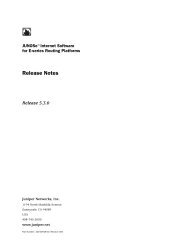
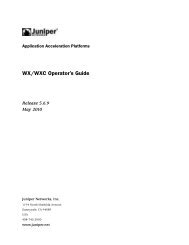
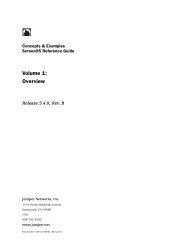

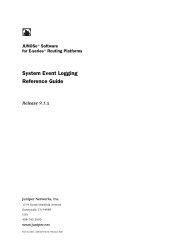
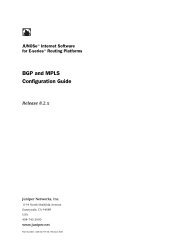
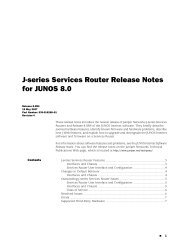
![PDF [11.5 MB] - Juniper Networks](https://img.yumpu.com/46780880/1/190x146/pdf-115-mb-juniper-networks.jpg?quality=85)
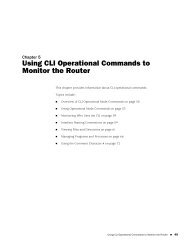
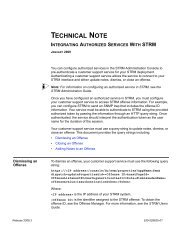
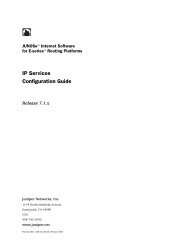


![Entire manual as PDF [2128 KB] - Juniper Networks](https://img.yumpu.com/33204313/1/190x245/entire-manual-as-pdf-2128-kb-juniper-networks.jpg?quality=85)
![Entire manual as PDF [3724 KB] - Juniper Networks](https://img.yumpu.com/32787982/1/190x245/entire-manual-as-pdf-3724-kb-juniper-networks.jpg?quality=85)